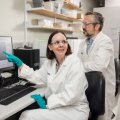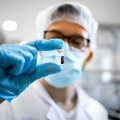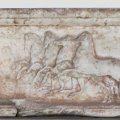The University of Queensland is set to enhance its position as a leading centre for magnetic resonance research with the establishment of the Queensland Nuclear Magnetic Resonance Network (QNN).
The $17 million QNN will establish a network of state-of-the-art high field nuclear magnetic resonance (NMR) equipment, including the most powerful machine of its kind in the southern hemisphere – a 900 MHz high-resolution spectrometer.
Inaugural director of the QNN, UQ's Professor Ian Brereton, said the Network would place Queensland at the forefront of international research in structural biology, biodiscovery and animal neuroimaging.
"The 900 MHz spectrometer has the highest field strength of any machine in Australia or the southern hemisphere, and is also the most powerful commercially available machine of its type in the world," Professor Brereton said.
"The facilities will allow researchers from universities, institutes and companies to carry out cutting edge research in a broad range of fields, in particular biodiscovery, drug design, neuroscience and instrument development."
He said NMR was a key technology for determining the structures of molecules and visualising the anatomy of living tissue and microscopic structure.
"It has revolutionised chemistry, diagnostic medicine and structural biology," he said.
"NMR is one of only two techniques available for determining the structures of proteins, providing the fundamental molecular information used in drug design programs."
He said researchers in regional Queensland centres would also benefit by having access to QNN's world-class research infrastructure from areas such as Townsville and Rockhampton, as well as provide access to the technology for the first time on the Sunshine Coast.
The State Government recently announced it will contribute $5 million to the QNN, as part of its Smart State strategy, which will go towards the purchase of the 900 MHz instrument at UQ, a 400 MHz instrument at QUT and an enhancement of an existing 600 MHz instrument at Griffith University.
UQ Deputy Vice Chancellor (Research) Professor David Siddle, said the awarding of Smart State funding represented recognition by the Queensland government of the importance of maintaining the State's research infrastructure at world-class levels to enable continuing excellence in biological research and in biotechnology.
He also said the State Government's contribution recognized UQ's 20-year strategic investment in NMR technology.
"The QNN will be a unique resource in Australia and will attract national and international researchers to establish UQ and Queensland as a central hub for NMR spectroscopy research in Australia," Professor Siddle said.
The 900 MHz high-resolution spectrometer optimised for biomolecular studies will add to an existing 750 MHz instrument at UQ, as well as the recently purchased 600 MHz instrument dedicated to biodiscovery and a 700 MHz wide-bore microimaging system capable of providing exquisitely detailed images of intact biological specimens, for example, the mouse brain in studies of neuroscience and neurodisease.
QNN participants include The University of Queensland, Queensland University of Technology, Griffith University, James Cook University, University of the Sunshine Coast and University of Central Queensland as well as biotech companies Spin Systems (Qld), Xenome, Kathera, Cyclagen and Protagonist.
International links to New Zealand have also been established with the participation of The University of Auckland and Massey University.
Media inquiries: Professor Ian Brereton (07 3365 4245) or Andrew Dunne at UQ Communications (07 3365 2802).
.jpg)



